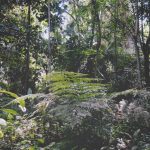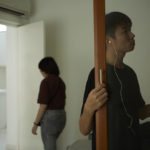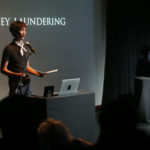Untitled
2013 - Sculpture (Sculpture)
13 1/8 x 10 3/8 x 3/4 in, 11 1/4 x 8 5/8 x 3/4 in, 12 5/8 x 9 1/2 x 1 1/4 in
Anna-Bella Papp
Untitled exemplifies the format that Anna Bella-Papp most commonly works in, using her hands to create delicate tablet-like reliefs within a rectangular form made out of clay. The lack of any glazes and other finishes used in traditionally in ceramics is a deliberate decision with an aim to preserve the pale hues and natural qualities of the clay. Papp’s decision to display the pieces resting flat on table tops, invites us to imagine them as landscapes or architectural structures seen from a bird’s-eye view. In this piece, the lines and stark formalism of the composition—the shape of a vertically oriented oval that has been cut out inside the rectangular tablet sitting beside a second oval-shaped incision that is deeper at one end—are reminiscent of Oscar Niemeyer’s modernist buildings or the amspaces built by Mies Van der rohe. In contrast to the monumental architecture it may suggest, the humble scale of Untitled (comparable to A4 paper size) demands a degree of proximity and intimacy with the viewer. Upon closer inspection it becomes clear: far from being models or maquettes, each permutation and trace of the artist’s hand is an object of beauty in itself.
Anna Bella-Papp recalls how intuitive it felt the first time she modelled something out of clay as a child. As something derived from the ground under us, clay always felt simple and familiar to her, and in part it’s that sense of immediacy that led her to work exclusively with unglazed and unfired clay. Papp’s hand-sculpted reliefs are modest in scale and consistently follow the format of a rectangle, which she then subtly modifies with unique incisions or marks, either building up or carving out parts of their surface. Working systematically within the same format allows for small changes and nuances to be imbued with meaning—each new mark becoming an experiment to gauge what range of expression can be wrought by such limited means. The result is a very palpable physicality evoked by simple and subtle forms. Working with and preserving the natural properties of clay is also important for Papp. Grey, white and ivory hues, and traces of fingerprints are left intentionally as clues that tell the story of where the material came from and how the object was made. Unlike stone, clay is constantly evolving—moving, contracting and changing color over time. Embracing this state of flux, Papp adjusts her body in relation to the clay as it changes, oscillating between making a mark and relinquishing control.
Colors:
Related works sharing similar palette

© » ARTS EQUATOR
Caring for the Carers: How Malaysian artists working with communities hold space | ArtsEquator Thinking and Talking about Arts and Culture in Southeast Asia ArtsEquator Viewpoints Courtesy of Syarifah Nadhirah August 12, 2021 By Rahmah Pauzi (1,300 words, 5-minute read) I had forgotten how loaded the words “how are you,” or “apa khabar,” can be...

© » KADIST
Prabhakar Pachpute
2020Calling attention to campaigns for land rights, survival, and sovereignty, Prabhakar Pachpute’s recent works consider how farmers in India use their bodies in performative ways during acts of protest...

© » KADIST
Rossella Biscotti
2014Rossella Biscotti’s “10×10” series investigates the relationship between demographics, data processing, textile manufacturing and social structure...

© » KADIST
With Martha Araújo, Milena Bonilla, Angelica Mesiti, Shitamichi Motoyuki and Emilija Škarnulyte Curated by Marie Martraire, director of KADIST, San Francisco Reflecting on the relationship between History and memory, the group exhibition Moving Stones focuses on the body as a site of engagement to address our collective past embodied in public monuments...

© » KADIST
Teresa Margolles
2014Stretching between San Pedro and the beach in Altata, Sinaloa, there is a 40 km road where there are three invisible borders controlled by rivalling armed groups...

© » KADIST
Kaoru Arima
2015Arima’s free brushstrokes gesture towards traditions in Expressionist painting, and Ticket could be seen as an attempt at “pure painting” in which the aesthetics of the medium supersede content...

© » SLASH PARIS
Antoine Grumbach — Les Yeux du Ciel — Jeanne Bucher Jaeger | Paris, Marais Gallery — Exhibition — Slash Paris Login Newsletter Twitter Facebook Antoine Grumbach — Les Yeux du Ciel — Jeanne Bucher Jaeger | Paris, Marais Gallery — Exhibition — Slash Paris English Français Home Events Artists Venues Magazine Videos Back Antoine Grumbach — Les Yeux du Ciel Exhibition Architecture, urban art, drawing, installation.....

© » KADIST
L’exigence de la saudade Curated by Zasha Colah and Sumesh Sharma, Clark House Initiative, Bombay With: Padmini Chettur, Prajakta Potnis and Zamthingla Ruivah And the participation of: Nalini Malani, Krishna Reddy, Jean Bhownagary, Maarten Visser Intervention in the public space by: Justin Ponmany, Prabhakar Pachpute The exhibition brings together three artists from distant geographies within India – Padmini Chettur, a contemporary dancer, Prajakta Potnis, a visual artist, and Zamthingla Ruivah, a master weaver, whose works are conceptually engaged with remnant cultural forms, not as endangered traditions, rather to reinvent them in the present...

© » ARTS EQUATOR
Silent Rooms, Silent Memories: “Flowers” by Drama Box | ArtsEquator Thinking and Talking about Arts and Culture in Southeast Asia Articles Drama Box May 16, 2019 By Akanksha Raja (1,155 words, 5-minute read) It’s a series of plastic white flower-fans lining the fence of 74 Jalan Kelabu Asap that lets me know that I’ve arrived at the site of Drama Box’s first work of 2019, Flowers , an experiential installation set in a quaint two-storey landed house in Chip Bee Gardens...

© » KADIST
Farah Al Qasimi
2022Um Al Dhabaab (Mother of Fog) by Farah Al Qasimi addresses the myth of Al Qasimi tribe-instigated piracy in the Gulf, perpetuated by the British Empire and upheld by contemporary western academia...

© » KADIST
Mathieu Abonnenc
2015Secteur IX B is full of ghosts: some that you can see, briefly appearing at the turn of a statue in an under construction museum, some that you only dream of when you switch from day to night, of one space to another...

© » KADIST
Artur Zmijewski
2002Zeppelintribüne (2002) was shot near the Zepelintribune in Nuremberg, designed by Albert Speer, chief architect of the Third Reich...








